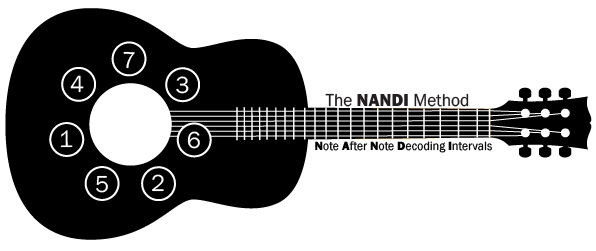Hello!
Welcome to The NANDI method website – Decode In Fourths & Unleash The Fretboard!
Many guitarists understand that the guitar fretboard, with over 130 notes, presents many challenges. Unlike the piano, which is linear and has all the notes laid out horizontally, there are no visual clues to help you figure out a note’s identity on the fretboard but for the note markers on certain frets. While many students aim to circumvent these challenges by memorizing patterns on the guitar, a single method that will help you overcome these deficits remains elusive.
To remedy this situation, I have developed a novel method of interval training called the NANDI method. NANDI is short for Note After Note Decoding Intervals. This method provides a fresh and novel perspective of the fretboard to help you understand the where, why, and hows of note and interval locations.
The NANDI Method is one of the only methods available to teach you to read the fretboard as alphabetical notes and numbers or musical intervals. An interval is a distance in pitch between any two notes.
What sets this teaching method apart from others is the absence of root memorization strategies often associated with traditional fretboard learning systems.
Because the NANDI Method centers around the fretboard’s logic, you avoid spending precious time and energy — the energy you can otherwise devote to honing technical skills, such as bending, vibrato, hammer-ons, and pull-offs.
The guitar is tuned mostly in fourths with a single major third tuning. This fourth pattern is at the core of the NANDI method. Its almost linear appearance makes this interval pattern easier to visualize on the fretboard.
We will utilize the primary natural note pattern of fourths (B-E-A-D-G-C-F) to help you read and locate notes on adjacent strings and non-adjacent strings.
Every guitarist’s ultimate goal should be to see the guitar as interval numbers instead of just notes, regardless of the key. All scales and chords in the major family, for example, share the same numeric formula. So, we cannot stress the importance of visualizing the fretboard in intervals enough.
The 12 chromatic interval numbers ordered in fourths (1-4-♭7-♭3-♭6-♭2-♭5-7-3-6-2-5-1) form the basis for locating any interval on any string from any fret location, even if you do not know the identity of the letter note behind the interval number. This method is the only available method that can help you recognize naturally occurring interval patterns on different string sets without memorization.
The fourth pattern and other interval patterns embedded within the fourth pattern are the keys to unlocking the fretboard and figuring out note locations, alterations, and inversions.
The objective here is to learn an alternate method that does not require memorizing every single note’s fret locations on the guitar.
Music students have different learning modalities. For those who prefer learning using technology, The NANDI method offers dynamic guitar interval training apps. Rather than displaying slides with interval shapes to be memorized, the exercises and games within the app challenge you to figure out answers to prompts, providing hints when necessary. These apps are available on Google Play and the Appstore.
For the student who prefers to practice writing notes, there is the first-of-its-kind NANDI Chorder: a dry erase board with a printed fretboard designed for both right and left-handed players, available for purchase on Amazon, eBay, and Etsy. You can use the NANDI Chorder over and over again for endless hours of practice.
The lessons on this website cover a wide variety of topics as taught by the NANDI method to help you with note and interval recognition relatedes to chords, scales, and arpeggios. The objective is to help you achieve your goal of understanding and learning the fretboard faster and more effectively than pursuing more traditional methods not based on any type of logic.
The NANDI method is perfect for guitar students of all skill levels looking for a practical, logical, and verifiable fretboard learning system that does not take months or years to master. It is a comprehensive methodology that takes you from building simple intervals to complex jazz voicings.
